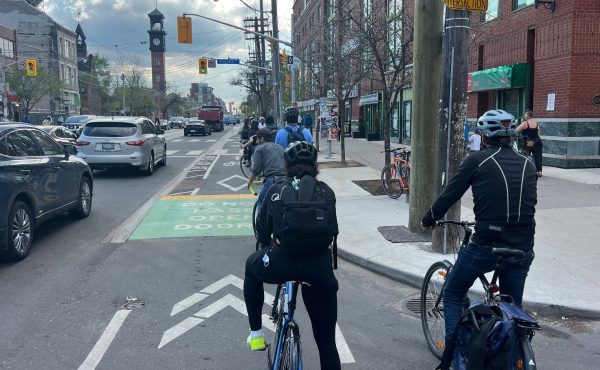Our ideas about travel behaviour provide the foundation of transportation policy. Is rail transit really more attractive to potential users than buses? Does dense mixed-use development reduce car use, or does it just attract people who don’t use cars much anyway? Why don’t kids walk to school anymore, and should we even worry about it? As transportation becomes a major issue, these kinds of questions are popping up more and more in the media (a recent favourite of mine is The Economist‘s article about the science of pedestrian behaviour).
Last week, I had the privilege of attending a couple of sessions at the International Association for Travel Behaviour Research annual conference held here in Toronto this year (of which Spacing was a co-sponsor). As someone interested in urban policy who talks about these issues often, the effect was like looking under the hood of a vehicle you use all the time and seeing the very complicated process that goes into making it work. But while the mechanism was often baffling, the results were very interesting.
The conference papers would start with a question I’m familiar with. Then after describing the method used to gather statistical evidence, they would launch into a series of complex mathematical and statistical calculations for getting a result, which were beyond my comprehension. Finally, they would end with an interesting and highly relevant conclusion. Fortunately, most of the others in the room understood the complex calculations and were, based on the questions asked, more than willing to scrutinize them to make sure the calculations and assumptions were valid. It gave me confidence that even if I didn’t always understand the process, the results were worth paying attention to.
One of the big questions in urban and transportation policy is whether mixed-use, dense development actually reduces car use and improves health by getting people walking and cycling, or whether people just self-select their living environment based on their personal preferences, with car-loving people moving to the suburbs (and then gaining weight because they’re simply not interested in exercising).
Two of the papers looked at this question, in Lisbon and in Belgian Flanders. Both came to the same conclusion — that while there is definitely some self-selection, the built environment is also influential in shaping people’s behaviour (a conclusion also reached in a recent Toronto Public Health report). The Lisbon study also made the point that it’s not just where people live, but also where they work, that affects travel choices — people who worked in concentrated employment areas downtown were far more likely to take transit than those who worked in more dispersed locations. And the Flemish study made the point that people’s attitudes can be changed — many of the car-oriented people were only moderately so and their attitudes could be shifted, whether by information campaigns or by improving their urban environment to make walking, cycling and transit use more appealing.
Another fascinating study compared who emitted pollution versus who experieced it in metropolitan Montreal. Looking at NO2 (Nitrogen Oxide) emissions from vehicles (using specific information about the types of vehicles owned in specific areas correlated with travel patterns), it found that people in the centre of the city produced low emissions — they did not travel by car a lot — but experienced very high emissions from cars coming in from outer parts of the city (even more so because people who are walking and cycling breathe in more air). The effect is even stronger because taller, denser buildings reduce the rate at which pollution is dispersed. Conversely, people in the outer reaches of the city enjoyed quite clean air but produced a great deal of pollution through driving into town.
While both of these conclusions might seem fairly self-evident, the fact is that these studies move these ideas from being assumptions to being evidence-based conclusions that can form the basis for public discussion and policy-making.
Some of the other interesting tidbits I picked up at the conferene:
– The Lisbon study found people with high environmtal awareness are, paradoxically, more likely to own cars — likely because they tend to be higher income — but they use them less than car owners with low environmental awareness.
– The Lisbon study also found that people who dislike public transportation focus on its crowding and uncleanliness, whereas people who like it focus on its convenience and reach. They are thinking in different categories. Also, the longer people’s commutes, the less likely they are to have a positive impression of transit.
– Studies are starting to indicate that air pollution increases the risk of heart attacks. The heart doesn’t change its rate in response to activity as well in polluted air.
– people with older cars use them less, so the effect of old cars on pollution levels is less than one might expect.
– Zurich is equipping people with GPS trackers to follow their transit decisions. But they only did 18 people for a week. I wonder if you could do this on a mass scale with smartphone GPS? A complication is that they are finding it very time-consuming to match the GPS info to transit routes. And of course tunnels are another complication.
– A Texas study discovered that people who notice a lack of sidewalks are actually more likely to walk — probably because only the walkers ever notice this problem.
– The Texas study found that there’s a causation relation (not just correlation) between people using active transportation to get to work, and engaging in other exercise activities too. So there’s a potential for mutual support between health inititatives and active transportation initiatives.
– People whose work is physical (e.g. factory workers, construction) are less likely to use active transportation or do other exercise, which is hardly surprising — they’re already getting plenty of physical activity.
– Losing a driver’s license for a month is a much bigger disincentive to drunk driving for young people than a higher fine.
– In conversation with a German academic, he told me that in Germany, the car companies support and partner with congestion-reducing policies including transit and active transportation, since that makes for a better experience for those who do drive. An example is the Car2Go car-sharing company backed by Daimler, which recently launched in Toronto — I guess Daimler figured out that if congestion is going to get reduced, they may as well find a way to profit from it.
photo by Todd Lappin






2 comments
With respect to the Zurich study with GPS, to some extent we don’t need to use this technology to capture transit users’ route choices because our local travel survey already gathers information about what transit lines users travel on. The trickier part is generating the choice-set of paths of which the chosen path is but one alternative. In other words, even if we know what path you took, figuring out what paths you didn’t take (but were available to you) is a non-trivial task. In Zurich, the researcher used a particular travel assignment platform (MATSim) to do this; you may be interested to know that this is a platform which myself and other colleagues are also working on implementing for Toronto.
“people who worked in concentrated employment areas downtown were far more likely to take transit than those who worked in more dispersed locations”
Well duh! Concentrated employment areas a far more likely to have convenient public transit in the first place. You really can’t have one without the other, Concentrated employment areas and higher order public transit. Toronto’s own Eirc MIller (UofT Prof) has made this point before. Employment Density is a larger factor in determining PT utilization than population density.